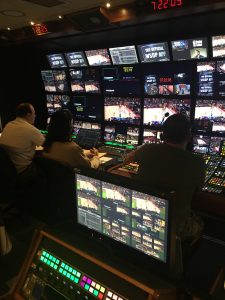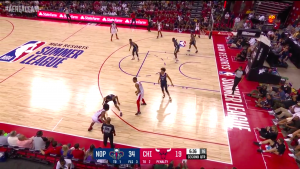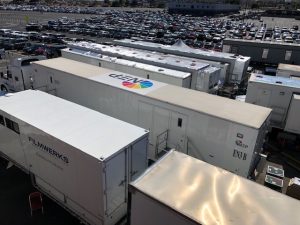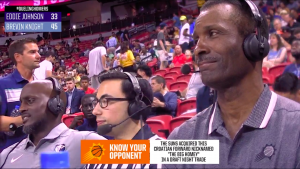2019 NBA Summer League, Part 3: ESPN Puts Flurry of Tech to the Test
A menu of alternative broadcasts mark the event in the desert
Story Highlights
When the then-named Las Vegas Summer League launched in 2004, the league’s elite prospects finally had a place to ball in the months leading up to the season. Since then, the University of Nevada, Las Vegas’s (UNLV) Thomas & Mack Center has become the center of the professional-basketball world for 11 days in July. This year, ESPN is covering all 83 games with a reinvigorated spirit of innovation on the technological and digital fronts.
“We work with great partners in the NBA to have the perfect platform and opportunity to bring out new toys and technology,” says Patty Mattero, senior operations manager, ESPN. “We’re all able to take a look into new interests and work together towards the future.”
MORE FROM NBA SUMMER LEAGUE
- The League Heads to the Next Technological Frontier
- Data-Tracking Reaches New Heights
- NBA Produces World’s First 5G Smartphone Broadcast
New Vantage Points, Education, and Some Fun on the App
The network has given digital-savvy consumers a buffet of second-screen experiences on the ESPN App and ESPN3. With 10 games getting special digital broadcasts, the Summer League has become a haven for fans in the young age demographic that is constantly on the go.
“Our fan base is extremely large, so [we need] to be able to touch upon technology for everybody’s appetite [throughout] different generations,” Mattero explains. “The viewer can control the look of our games. These offerings will [further] enlarge the fan base and provide whatever choices they want [for consuming] content. While we’re at the Summer League, we’ll be able to [implement] them faster [in] the present and the future by testing all of these new ideas.”
To begin the alternative viewing options on July 6, ESPN kicked back, vibed out, and chilled during a laidback broadcast called Group Textcast during a rematch of the 2019 NBA Finals between the Toronto Raptors and Golden State Warriors. In a unique meshing of the linear and digital broadcasts, 2KTV Host/Producer Alexis Morgan, NBC Sports Bay Area Host/Anchor Grant Liffmann, and co-host of NBC Sports Bay Area’s Warriors Outsiders podcast Drew Shiller took fan questions via the NBA Summer League Twitter account and gave answers in real time. The stream provided a lighthearted and friendly take on a game, especially since Liffmann also works on the same podcast as Shiller.
The fun continued during the following night’s Chicago Bulls vs. Cleveland Cavaliers contest with a similar concept seen during Game 2 of last year’s Finals. Naming it the “PopCast,” ESPN offered a wealth of digestible facts, unknown player info, and more with the help of the league itself.
“The NBA broadcast team, under the direction of [NBA Entertainment Director, Broadcasting,] Paul Benedict, prepared over 600 factoids and used approximately 300 of them,” says Steve Hellmuth, EVP, media operations and technology, NBA Entertainment. “I thought it was really appropriate for a Summer League game because there are so many players on the court that fans might not know. These are all guys that are getting their shot [in the league], and [fans may] want to know more about them.”
A trio of games has brought fans to the front row and the rafters with Courtside Experience for the Washington Wizards vs. Brooklyn Nets at 5:30 p.m. ET and with Aerial Cam for the New Orleans Pelicans vs. Chicago Bulls at 9:30 p.m. On the former telecast, cameras positioned 10 rows back from the action and others along the baselines replicated the feeling of watching the game from the best seats in the house.
Zion showing off his strength EARLY 😳💪#NBASummer pic.twitter.com/dXLBYqtWum
— NBA TV (@NBATV) July 6, 2019
For the nightcap, a Spydercam presented a videogame-style of viewing from overhead. A Supracam two-point system was used last night during the Utah Jazz vs. Houston Rockets matchup.
The digital streams also got the commentator teams involved. During this past week’s game featuring the Phoenix Suns and the Memphis Grizzlies, former Grizzlies player Brevin Knight and former Suns player Eddie Johnson were “Dueling Homers,” facing off in multiple in-game challenges, including predictions and trivia on the opponent’s team or playing career.
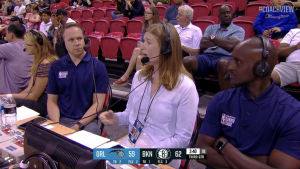
The Orlando Magic’s Becky Bonner gave an inside look into front-office operations on “Coach’s View.”
With a more educational approach, ESPN charged ahead with “Coach’s View” during Orlando Magic vs. Brooklyn Nets in accordance with Coaches Appreciation Day on July 10. Current and past coaches gave insight on the nuances of the job with live footage of instructional drills and film breakdown. Representatives from each team, including Becky Bonner, director, player development and quality control, Orlando Magic, explained what it’s like to be in the front office of any of the league’s 30 teams.
Action-Packed Schedule in Two Separate Venues
To fit the lengthy schedule in a somewhat short time span, ESPN balanced broadcasts in the Thomas & Max Center and the Cox Pavilion. To stay connected, the network developed a complex workflow to tap into each individual mobile truck.
“NEP’s EN3 is our main truck that services Thomas & Mack, and that is interconnected with NEP’s M11, which is used for the primary coverage in Cox Pavilion,” says Eddie Okuno, senior remote operations specialist, ESPN. “EN3 mobile unit is serving our distribution point, and that’s connected to the Mobile TV Group truck [that houses] the NBA optimal production [team].”
For each game inside these trucks, the production team is working with two EVS replay servers and a GREMI (graphics remote integration) workflow generated at ESPN headquarters in Bristol, CT. Another offsite location, in Los Angeles, is helping with a Las Vegas-version of The Jump. The four-camera show is being facilitated with an at-home production (or ESPN’s REMI).
Along with aerial cameras, the typical game-day complement rounds out to around six per game, with a slightly higher count in the Thomas & Mack Center. A majority of the complement is dedicated to capturing POV shots.
“We’ve sprinkled in four Marshall POVs for extended look-ins and extended overall coverage on the concourse and crowd [based on the game],” says Mattero. “Our announce tables have gooseneck [flexible] camera mounts. In the Thomas & Mack Center, we also have two cameras on a stage where we do a lot of player and coach interviews.”
In addition to the day-to-day hoops that need to be jumped through, Mattero, Okuno, and their staff had to navigate the sudden and violent tremors felt from a 6.4-magnitude earthquake that hit California.
“It was a little scary, especially for a lot of us East Coasters that don’t really experience or have never experienced earthquakes before,” Mattero says. “We didn’t lose any power, and there wasn’t any structural damage to the arenas. However, when anything like this does happen, protocol and safety kick in first. The NBA and [personnel at] the venues pulled in engineers and did full inspections of the floors and camera platforms to make sure that everything is 100% safe for everyone to continue working.”
Full Speed Ahead With the NBA
From the planning stages to the eventual real-world execution of these concepts, ESPN and the NBA have worked closely on this technological adventure. As the final weekend of the Summer League unfolds, the broadcaster is relishing its fruitful partnership with the league.
“[Our relationship] is the quintessential collaboration between broadcast partners and the NBA. We’re all working to expand the growth and advancement of the NBA product and ESPN,” says Okuno. “We would never have that opportunity, nor the privilege of doing this if we didn’t have the tremendous cooperation from the NBA.”
The 2019 NBA Summer League continues on the ESPN family of channels through the weekend and concludes with the Championship game inside Thomas Mack & Center on Monday, July 15 at 9 p.m. ET on ESPN2 and the ESPN App.
